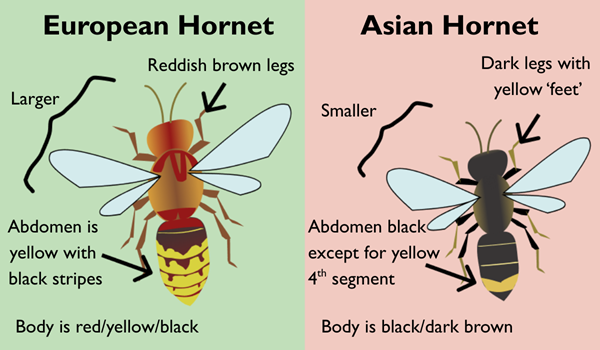By Jayna Connelly, Science Communicator
By now, most people have heard of the dreaded Asian hornet — large, scary, and most definitely evil-looking… or so the rumours go. Many claim they’ve seen one. But how common are they in the UK, and are they really a problem?
First officially spotted in Gloucestershire in 2016, this species has since been recorded as far away as Cork in Ireland. There’s no doubt that Asian hornets pose a serious threat to our native and already fragile wildlife populations.
New research has revealed the wide range of insect species these hornets prey upon. They are opportunistic hunters, feeding on virtually any insect they can catch — not just honeybees. Crucially, 43 of the 50 most common insect species found in the guts of Asian hornets are flower-visiting species. This highlights the serious threat they may pose to our invaluable network of pollinators in the UK.
It’s important to remember that we also have our own species of native hornet. This red-and-yellow, relatively docile species plays a valuable role in our ecosystems, providing natural pest control and helping to keep insect populations in balance. The Asian hornet might not be as common as is often portrayed so it is always best to proceed with caution and leave the control measures to an expert.
When speaking to people who spend a lot of time in the countryside — those most likely to spot an Asian hornet — a common belief is that they are big, black and bad. While that’s not entirely wrong, the crucial distinction is that Asian hornets are actually smaller than our native European hornet.

Key things to look for when identifying hornets:
- Asian hornet: Smaller, mostly dark, with bright yellow legs and a single vivid band on the abdomen. Workers have ~20mm wingspan.
- European hornet: Larger, boldly striped yellow and brown, with brown legs. Workers have ~25mm wingspan.
Whether you’re a farmer, land manager, gamekeeper, or simply passionate about conserving our countryside and its wildlife, you can play a huge role in protecting our native species and spreading awareness about invasive ones.
The best thing to do if you spot a hornet you’re suspicious of is to take a clear picture and leave it alone. Then report it online or by downloading the official Asian Hornet Watch app.